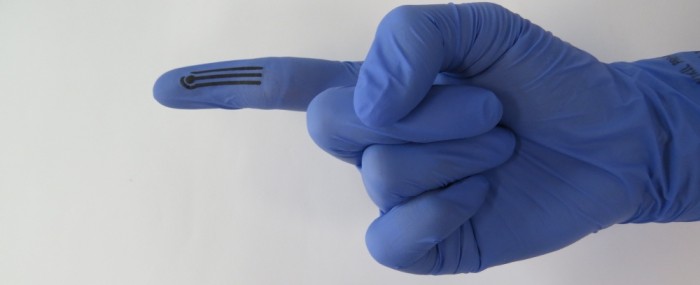
Scientists at the University of São Paulo create a glove that detects pesticides in food
25 de janeiro de 2022By Karina Ninni | FAPESP Innovative R&D – Scientists at the University of São Paulo (USP) in Brazil have created a wearable device to detect pesticide residues in foodstuffs. The device consists of a synthetic rubber glove with sensors in three fingers. The project was supported by FAPESP and led by chemist Paulo Augusto Raymundo-Pereira, a researcher at the São Carlos Physics Institute (IFSC-USP).
The sensors are electrodes screen-printed on the index, middle and ring fingers using conductive carbon ink. They detect carbendazim (a carbamate fungicide), diuron (a phenylamide herbicide), paraquat (a bipyridyl herbicide), and fenitrothion (an organophosphorus insecticide). In Brazil, carbendazim, diuron e fenitrothion are used on grain crops (wheat, corn, soybeans, dry beans, rice), citrus, coffee, cotton, cocoa, bananas, pineapples, apples and sugarcane. The use of paraquat has been banned by ANVISA, the national health surveillance agency.
The presence of these substances in a liquid can be detected by immersing the tip of a finger in the sample, or in fruit and vegetables by touching their surface.
An article on the device is published in Chemical Engineering Journal.
According to Sergio Antonio Spinola Machado, a professor at the university’s São Carlos Chemistry Institute (IQSC-USP) and penultimate author of the article, there is nothing similar on the market and the methods currently used to detect pesticides involve chromatography (separation of a mixture into its components), spectrophotometry (measurement of light absorption to determine the amount of a substance in a sample), electrophoresis (separation of molecules based on size and electrical charge) or laboratory assays.
“All these techniques are expensive, require skilled labor, and take a long time to produce results,” he said. “Our sensors are an alternative to the conventional techniques, enabling fast, reliable and robust analysis in situ and at low cost.”
Each finger of the glove detects a different pesticide class. Detection is electrochemical and requires water. “The water is necessary because we need an electrolyte [to conduct electric current by forming positively and negatively charged ions]. A drop of water is sufficient to establish contact between the fruit or vegetable and the sensor. Detection occurs at the interface between the sensor and the solution,” said Nathalia Gomes, also a researcher at IQSC-USP and second author of the article.
Sensors
The complete procedure for detecting the presence of pesticides with the glove is indeed simple. One finger at a time is placed on or in the sample – first the index finger, next the middle finger, and lastly the ring finger. In the case of fruit juice, for example, the tips of the same fingers are placed in the liquid one at a time. The device takes a minute to analyze the data – less, in the case of the ring finger.
“The ring finger sensor uses a faster technique,” Raymundo-Pereira explained. “It consists of a functionalized carbon electrode, whereas the other two sensors are electrodes modified with carbon spherical shells [index finger] and Printex carbon black, a specific type of carbon nanoparticle [middle finger]. After detection, software running in a smartphone analyzes the data.”
Carbon-based materials enhance the sensors’ sensitivity, one of the most important properties and hard to achieve in devices like this one. “Our judicious choice of carbon-based materials permits sensitive and selective detection of four classes of pesticides among those most widely used in agriculture: carbamates, phenylamides [a subclass of phenylureas], bipyridinium compounds, and organophosphates,” he said. “One of the main novelties in this invention is selective detection in the presence of other groups of pesticides, such as triazines, glycine substitute, triazole, strobilurin, and dinitroaniline. That isn’t possible with traditional methods.”
Another distinguishing feature of the device is direct detection without sample preparation, making the procedure faster and helping to conserve foodstuffs, which can be consumed after the analysis.
The glove has no expiration date and can be used indefinitely unless the sensors are damaged. According to Osvaldo Novais de Oliveira Junior, also a professor at IFSC-USP and last author of the article, the sensors can be damaged by organic solvents, such as alcohol or acetone, and by improper mechanical contact, such as rubbing a rough surface, for example.
Market
Raymundo-Pereira stressed that the product is innovative and that a patent application has been filed with INPI, Brazil’s patent and trademark office. There are no simple procedures for pesticide detection; this is the main reason for which tests to distinguish between different pesticide classes and other contaminants are not yet available on the market. Devices like the glove that permit in situ chemical analysis of hazardous materials would be useful in situations such as inspection of food or premises, forensics, and health and safety, helping those responsible make decisions quickly in the field.
“Representatives of the agencies that control food imports in several countries already use gloves to handle products. Imagine if the gloves had embedded pesticide sensors. Food products that contained banned pesticides could be discarded then and there, at the border checkpoint,” he said. “It would also be perfectly feasible to use the device while crops are being harvested.”
The cost is basically the same as the cost of the glove alone. “The sensors cost less than a cent each. The glove is the main cost item,” he explained. “We use a nitrile rubber glove because it’s less porous than latex. The price has soared during the pandemic, but the device is still very inexpensive and much more affordable than existing tests.”
The research and development was funded by FAPESP via four projects (16/01919-6; 20/09587-8; 19/01777-5; and 18/22214-6).
The article “Selective and sensitive multiplexed detection of pesticides in food samples using wearable, flexible glove-embedded non-enzymatic sensors” is at: www.sciencedirect.com/science/article/pii/S1385894720334045.
